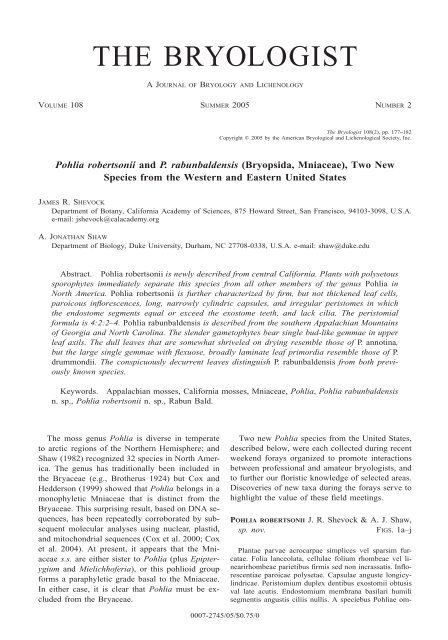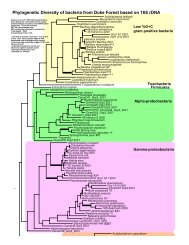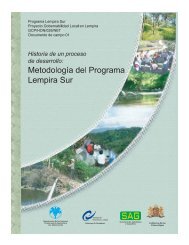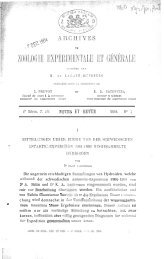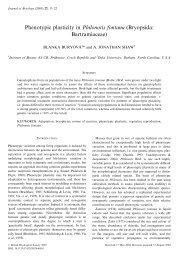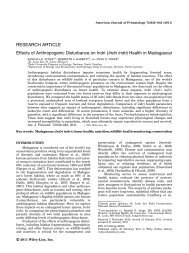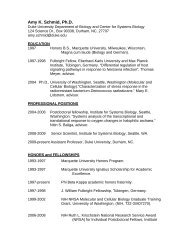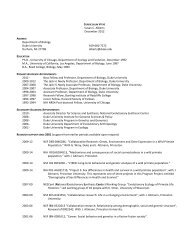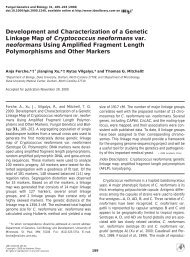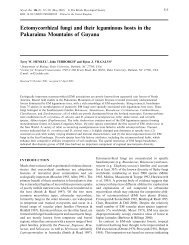THE BRYOLOGIST - Duke Biology Department - Duke University
THE BRYOLOGIST - Duke Biology Department - Duke University
THE BRYOLOGIST - Duke Biology Department - Duke University
Create successful ePaper yourself
Turn your PDF publications into a flip-book with our unique Google optimized e-Paper software.
<strong>THE</strong> <strong>BRYOLOGIST</strong><br />
AJOURNAL OF BRYOLOGY AND LICHENOLOGY<br />
VOLUME 108 SUMMER 2005<br />
NUMBER 2<br />
The Bryologist 108(2), pp. 177 182<br />
Copyright 2005 by the American Bryological and Lichenological Society, Inc.<br />
Pohlia robertsonii and P. rabunbaldensis (Bryopsida, Mniaceae), Two New<br />
Species from the Western and Eastern United States<br />
JAMES R. SHEVOCK<br />
<strong>Department</strong> of Botany, California Academy of Sciences, 875 Howard Street, San Francisco, 94103-3098, U.S.A.<br />
e-mail: jshevock@calacademy.org<br />
A. JONATHAN SHAW<br />
<strong>Department</strong> of <strong>Biology</strong>, <strong>Duke</strong> <strong>University</strong>, Durham, NC 27708-0338, U.S.A. e-mail: shaw@duke.edu<br />
Abstract. Pohlia robertsonii is newly described from central California. Plants with polysetous<br />
sporophytes immediately separate this species from all other members of the genus Pohlia in<br />
North America. Pohlia robertsonii is further characterized by firm, but not thickened leaf cells,<br />
paroicous inflorescences, long, narrowly cylindric capsules, and irregular peristomes in which<br />
the endostome segments equal or exceed the exostome teeth, and lack cilia. The peristomial<br />
formula is 4:2:2–4. Pohlia rabunbaldensis is described from the southern Appalachian Mountains<br />
of Georgia and North Carolina. The slender gametophytes bear single bud-like gemmae in upper<br />
leaf axils. The dull leaves that are somewhat shriveled on drying resemble those of P. annotina,<br />
but the large single gemmae with flexuose, broadly laminate leaf primordia resemble those of P.<br />
drummondii. The conspicuously decurrent leaves distinguish P. rabunbaldensis from both previously<br />
known species.<br />
Keywords. Appalachian mosses, California mosses, Mniaceae, Pohlia, Pohlia rabunbaldensis<br />
n. sp., Pohlia robertsonii n. sp., Rabun Bald.<br />
The moss genus Pohlia is diverse in temperate<br />
to arctic regions of the Northern Hemisphere; and<br />
Shaw (1982) recognized 32 species in North America.<br />
The genus has traditionally been included in<br />
the Bryaceae (e.g., Brotherus 1924) but Cox and<br />
Hedderson (1999) showed that Pohlia belongs in a<br />
monophyletic Mniaceae that is distinct from the<br />
Bryaceae. This surprising result, based on DNA sequences,<br />
has been repeatedly corroborated by subsequent<br />
molecular analyses using nuclear, plastid,<br />
and mitochondrial sequences (Cox et al. 2000; Cox<br />
et al. 2004). At present, it appears that the Mniaceae<br />
s.s. are either sister to Pohlia (plus Epipterygium<br />
and Mielichhoferia), or this pohlioid group<br />
forms a paraphyletic grade basal to the Mniaceae.<br />
In either case, it is clear that Pohlia must be excluded<br />
from the Bryaceae.<br />
0007-2745/05/$0.75/0<br />
Two new Pohlia species from the United States,<br />
described below, were each collected during recent<br />
weekend forays organized to promote interactions<br />
between professional and amateur bryologists, and<br />
to further our floristic knowledge of selected areas.<br />
Discoveries of new taxa during the forays serve to<br />
highlight the value of these field meetings.<br />
POHLIA ROBERTSONII J. R. Shevock & A. J. Shaw,<br />
sp. nov. FIGS. 1a–j<br />
Plantae parvae acrocarpae simplices vel sparsim furcatae.<br />
Folia lanceolata, cellulae folium rhombeae vel linearirhombeae<br />
parietibus firmis sed non incrassatis. Inflorescentiae<br />
paroicae polysetae. Capsulae anguste longicylindricae.<br />
Peristomium duplex dentibus exostomii obtusis<br />
val late acutis. Endostomium membrana basilari humili<br />
segmentis angustis ciliis nullis. A speciebus Pohliae om-
178 <strong>THE</strong> <strong>BRYOLOGIST</strong><br />
[VOL. 108<br />
FIGURE 1. Pohlia robertsonii. — a. Capsules. — b. Mature gametophytes. — c. Maternal plant bearing three setae.<br />
— d. Peristome, viewed from outside. — e. Peristome, viewed from inside. Cell outlines demonstrate the 4:2:4 peristomial<br />
formula (one column of cells between segments). — f. Stomate. Note that guard cells overlap surrounding<br />
exothecial cells. — g. Annular cells. — h. Exothecial cells. — i. Vegetative leaves. — j. Perichaetial leaf, with recurved<br />
margins. — k. Leaf apex. — l. Upper median leaf cells. Scale bars: a–c: 1.0 mm; i–j: 0.5 mm; others as marked.
2005] SHEVOCK & SHAW: POHLIA<br />
179<br />
nibus in America septentrionali ad septentriones Mexiconis<br />
inflorescentiis polysetis diagnoscenda.<br />
TYPE: U.S.A. CALIFORNIA. Monterey Co. Wagon Caves<br />
just north of boundary with Fort Hunter-Liggett Military<br />
Reservation off of Forest Road to The Indians, Los Padres<br />
National Forest, 360500 N, 1212405 W, 22 Mar 2004,<br />
295 m, Shevock et al. 24722 (CAS, holotype; DUKE, H,<br />
KRAM, MO, NY, UC, isotypes).<br />
Paratypes.—U.S.A. CALIFORNIA. Monterey Co., Wagon<br />
Caves, Shevock & Kellman 24787 (CAS, DUKE, UBC, UNAM),<br />
Robertson 6134, 6331 (UC), Norris & Hillyard 106947<br />
(UC); on divide about 0.8 km south of Santa Lucia Park,<br />
Los Padres National Forest, Shevock et al. 24771 (CAS,<br />
MO, NY); off of Gabilan Road at the Palisades above the<br />
Nacimiento River, Hunter-Liggett Military Reservation,<br />
Shevock et al. 24858 (CAS, DUKE, MO, NY) and Shevock et<br />
al. 24863 (CAS).<br />
Small light green plants forming abundantly fertile<br />
populations on sandy soil. Stems unbranched or<br />
with 1–2 innovations or forks below inflorescences<br />
or near base, in transverse section with central,<br />
poorly delimited region of small thin-walled cells<br />
surrounded by larger thin-walled cells and 2–4 layers<br />
of smaller thickened surficial cells. Vegetative<br />
leaves lanceolate, 1.3–1.6 mm long, 0.3–0.7 mm<br />
wide, acute; margins plane or weakly recurved in<br />
upper third, serrulate to serrate near apices or sometimes<br />
nearly to midleaf; costae well-developed,<br />
ending 3–5 cells below leaf apices. Upper leaf cells<br />
irregularly hexagonal to rhomboidal, 70–120 m<br />
long, 6–9 m wide, with firm but not thickened<br />
walls, undifferentiated along margins. Basal cells<br />
gradually wider, thinner-walled, and more nearly<br />
rectangular, 50–65 (75) m long, 15–24 m<br />
wide. Paroicous. Perichaetial leaves slightly differentiated<br />
from vegetative leaves, to 2.0 mm long,<br />
with more conspicuously recurved margins. Setae<br />
erect, orange-brown, and slightly darker toward<br />
base, ca 13 mm long. Capsule inclined ca 10 from<br />
vertical, cylindric to narrowly and longly pyriform,<br />
orange-brown to straw-colored when mature, often<br />
mottled with red when immature, ca 4 mm long,<br />
with neck equal to or somewhat longer than urn.<br />
Exothecial cells elongate-hexagonal, 65–110 m<br />
long, 11–15 m wide, with thickened, somewhat<br />
wavy walls, abruptly smaller and rounded-isodiametric<br />
or square at rim, with abundant stomata<br />
in neck. Operculum high conic, sharply pointed.<br />
Annulus revoluble, of two rows of cells. Peristome<br />
double, with endostome segments equal to or exceeding<br />
length of exostome teeth. Exostome teeth<br />
irregular, bluntly tapered, pale orange-yellow to<br />
brown; 90–160 m long, finely pitted in lower outer<br />
surface, coarsely papillose on upper surface.<br />
Endostome pale yellow-brown to nearly hyaline;<br />
basal membrane low, barely extending above capsule<br />
rim; segments narrow, to 175 m, keeled near<br />
bases, not perforate or sometimes irregularly so.<br />
Spores 16–20 m, finely but distinctly papillose.<br />
The current distribution of Pohlia robertsonii is<br />
restricted to Monterey County, south of San Francisco,<br />
where it occurs in Los Padres National Forest<br />
and Fort Hunter-Liggett Military Reservation. The<br />
species was first encountered on 22, March 2004<br />
during the 9th annual spring break West Coast bryological<br />
foray called the SO BE FREE. On the second<br />
day of the foray, participants organized into<br />
several smaller collecting teams with one team venturing<br />
into the Los Padres National Forest in the<br />
vicinity of The Indians. The first stop was at a spectacular<br />
sandstone rock formation in an open valley<br />
and blue oak woodland called Wagon Caves. The<br />
diversity of bryophytes at this site is extremely<br />
high. In short order several of the participants had<br />
in hand a moss with numerous polysetous sporophytes.<br />
The plants were reminiscent of Schizymenium<br />
shevockii Shaw, a species recently described<br />
from California collections (Shaw 2000), and that<br />
was the tentative genus name placed on the collections<br />
while in the field. When the group returned<br />
to the foray base camp at the U.C. Hastings Reserve<br />
later that day, microscopic examination of the<br />
gametophytes and sporophytes of the new taxon<br />
quickly ruled out Schizymenium because the sporophytes<br />
are clearly terminal and the perichaetial<br />
leaves are larger than the vegetative leaves (unlike<br />
in Schizymenium, where the perichaetial leaves are<br />
smaller than vegetative leaves). Review of the recently<br />
published California moss catalogue and<br />
keys (Norris & Shevock 2004a,b) clearly indicated<br />
that these plants were not included in that publication.<br />
It is also distinct from any species of Pohlia<br />
recorded from Mexico (Shaw in Sharp et al. 1994).<br />
Therefore speculation during the foray was that<br />
these plants represented an undescribed species.<br />
Habitat. Pohlia robertsonii occurs on sandy<br />
gravels and at the bases of rock walls, rock slabs<br />
and boulders on large volcanic, and sandstone formations<br />
in open deciduous woodland dominated by<br />
Quercus douglasii Hooker & Arnott and Q. lobata<br />
Neé, with scattered Pinus sabiniana Douglas. This<br />
vegetation type is common in the Coast Ranges of<br />
California. Plants of P. robertsonii are frequently<br />
associated with Anacolia baueri Hampe, Antitrichia<br />
californica Sullivant, Cephaloziella divaricata<br />
Schiffner, Grimmia lisae De Notaris, Hedwigia detonsa<br />
(Howe) Buck & Norris, Marsupella bolanderi<br />
(Austin) Underwood, Philonotis capillaris<br />
Lindberg, and Pseudobraunia californica (Lesquereux)<br />
Brotherus. Other rare mosses in this vicinity<br />
include Didymodon norrisii Zander and Schizymenium<br />
shevockii.<br />
Biogeographic patterns. Based on field work to<br />
date, Pohlia robertsonii is restricted to a narrow<br />
band of pinnacle-like volcanic and sandstone rock<br />
formations; a distance of only 35 km separates the
180 <strong>THE</strong> <strong>BRYOLOGIST</strong><br />
[VOL. 108<br />
northern and southernmost occurrences. Yet within<br />
this small geographic zone of suitable habitat, the<br />
species is common and nearly all populations include<br />
abundant sporophytes. The Coast Ranges of<br />
California remain poorly explored bryologically,<br />
notwithstanding recent collecting efforts in this portion<br />
of the state (Kellman 2003). In addition to<br />
Pohlia robertsonii, a species that on the basis of<br />
current collections appears to be a highly localized<br />
endemic, several species otherwise restricted in<br />
California to the Sierra Nevada have recently been<br />
found in this coastal region. These include Racomitrium<br />
depressum Lesq., Grimmia serrana J. Muñoz,<br />
Shevock & Toren, and Schizymenium shevockii.<br />
Recently described taxa from the Coast Ranges<br />
include Orthotrichum kellmanii (Norris et al.<br />
2004) and a new moss genus Dacryophyllum (Ireland<br />
2004). In addition, Campylopodiella stenocarpa<br />
(Wils.) P. Müller & Frahm, a species otherwise<br />
known from central Mexico, has been found at one<br />
of the P. robertsonii sites. Perhaps the most interesting<br />
flowering plant example is the southern Sierran<br />
endemic Carlquistia muirii (A. Gray) B. G.<br />
Baldwin, with a disjunct and remarkable occurrence<br />
at Ventana Double Cone in the central Coast Range<br />
(not far from P. robertsonii). Additional bryological<br />
collecting in this portion of California is likely<br />
to yield additional novelities and significant range<br />
extensions.<br />
Pohlia robertsonii is readily distinguished from<br />
all species of Pohlia in North America north of<br />
Mexico by the polysetous condition (Fig. 1c). The<br />
plants are paroicous and were abundantly fertile everywhere<br />
they were encountered. The capsules of<br />
P. robertsonii are narrow-cylindric (Fig. 1a) and<br />
resemble forms of P. elongata from Mexico and<br />
Central America that have been named P. spectabilis<br />
(but which Shaw 1982, synonymized with P.<br />
elongata). Also like P. elongata, P. robertsonii is<br />
paroicous and the endostome has narrowly (or not<br />
at all) perforate segments and lacks cilia (Fig. 1d,<br />
e). The exostome teeth of P. robertsonii are shorter<br />
and more irregular than is typical of P. elongata.<br />
Pohlia elongata also has more thickened leaf cells,<br />
and is consistently monosetous. Dry plants of P.<br />
elongata appear dull whereas those of P. robertsonii<br />
have a softer texture and are more glossy. The<br />
gametophytes of P. robertsonii are more like those<br />
of P. bolanderi (Sull. & Lesq.) Broth., which is<br />
widespread in mountainous areas of western North<br />
America. Pohlia bolanderi has monosetous inflorescences<br />
and is dioicous. Pohlia polycarpa (Mitt.)<br />
Broth., a polysetous Andean species known from<br />
as far north as Guatemala, has smaller, less narrowly<br />
cylindric capsules and exostome teeth that are<br />
longer and less irregular in development. Pohlia<br />
polycarpa is known from high mountains, in habitats<br />
very unlike those where P. robertsonii occurs.<br />
This species is named for Ronald Robertson, an<br />
active collector of California bryophytes. His collections,<br />
obtained primarily from the San Francisco<br />
Bay Area counties, have yielded many new occurrences<br />
of rare and infrequently encountered mosses.<br />
Ron was the first to collect this new species during<br />
the SO BE FREE foray and has been involved in<br />
locating all of the additional occurrences. It is a<br />
pleasure to name this species in his honor in recognition<br />
of his contributions to California bryology.<br />
POHLIA RABUNBALDENSIS A. J. Shaw, sp. nov.<br />
FIGS. 2a–d<br />
Plantae graciles hebetes gemmis axillaribus. Gemmae<br />
grandes gemmaeformes1–2 in axilla folii primordiis folii<br />
grandibus flexuosis laminaribus, Pohliae drummondii sed<br />
viridibus vel luteis non ruberis simulans. Sporophyta ignota.<br />
TYPE: U.S.A. GEORGIA. Rabun Co. Chattahoochee National<br />
Forest, mixed hardwood forest and gneissic rock<br />
faces on north-facing slopes of the bald, 1,130–1,435 m<br />
elevation, 3458 N, 8318 W, Shaw 8474. (DUKE, holotype;<br />
NY, isotype).<br />
Paratypes.—U.S.A. GEORGIA. Rabun Co. Chattahoochee<br />
National Forest, mixed hardwood forest and gneissic<br />
rock faces on north-facing slopes of the bald, 1,130–1,435<br />
m elevation, 3458 N, 8318 W, Shaw 8390, 8473, 8478<br />
(DUKE); Rabun Bald Cliffs, Zartman 2558 (DUKE). NORTH<br />
CAROLINA. Buncombe Co. Pisgah National Forest, along<br />
the Blue Ridge Parkway at Snowball Mtn., mixed hardwood<br />
forest with scattered Picea rubra, ca 1,500 m elevation,<br />
3542 N, 8224 W, Shaw 13614, 13615 (DUKE).<br />
Slender plants forming small populations or<br />
mixed with other mosses. Stems mostly unbranched,<br />
in transverse section with central, poorly<br />
delimited region of small thin-walled cells surrounded<br />
by larger thin-walled cells and 2–4 layers<br />
of smaller thickened surficial cells. Vegetative<br />
leaves lanceolate, noticeably decurrent, 0.8–1.4 mm<br />
long, 0.3–0.6 mm wide, acute; margins of vegetative<br />
leaves plane, serrulate near apices or sometimes<br />
nearly to midleaf; costae well-developed,<br />
ending 3–5 cells below leaf apices. Upper leaf cells<br />
rhomboidal, 70–105 m long, 9–12 m wide, with<br />
thin to firm walls, undifferentiated along margins.<br />
Basal cells gradually wider, thinner-walled, and<br />
more nearly rectangular, 45–65(–70) m long, 15–<br />
24 m wide. Axillary gemmae borne singly in (0)–<br />
3–6 upper leaf axils, 400–750 m long, orange or<br />
orange-yellow to reddish, with conspicuous, flexuose,<br />
broadly laminate leaf primordial near gemma<br />
apex as well as below, on gemma body. Apparently<br />
dioicous; male plants not seen. Perichaetial leaves<br />
triangular-lanceolate, to 2.2 mm long, with conspicuously<br />
recurved margins. Archegonia abundant.<br />
Habitat and biogeographic patterns. Pohlia ra-
2005] SHEVOCK & SHAW: POHLIA<br />
181<br />
FIGURE 2. Pohlia rabunbaldensis. — a. Gemmae. — b. Vegetative leaves. — c–d. Gemmiferous plants. Scale bars:<br />
a–b: 0.5 mm; c–d:1.0 mm.
182 <strong>THE</strong> <strong>BRYOLOGIST</strong><br />
[VOL. 108<br />
bunbaldensis was first collected during the 1996<br />
Blomquist Foray, an annual field meeting organized<br />
by <strong>Duke</strong> <strong>University</strong> in honor of Hugo Blomquist,<br />
the first professor of botany at <strong>Duke</strong>. Rabun Bald<br />
is the second highest point in Georgia, (1,432 m),<br />
less than 25 km south of the North Carolina state<br />
line. The Bartram Trail from Beegum Gap leading<br />
to the summit of Rabun Bald climbs gradually<br />
though a southern mixed hardwood forest with Kalmia<br />
latifolia L. and Rhododendron sp., until it<br />
reaches about 1,220 m elevation and climbs more<br />
steeply. At about that point, the vegetation changes<br />
to a ‘‘northern’’ Quercus rubra L. hardwood forest.<br />
Pohlia annotina (Hedw.) Lindb. is abundant along<br />
the trail below the Quercus rubra forest but is replaced<br />
by P. rabunbaldensis in similar microhabitats<br />
up to the summit. Both the P. annotina at lower<br />
elevations and the P. rabunbaldensis at higher elevations<br />
occur on exposed mineral soil along the<br />
trail. The ecological ranges of the two species appear<br />
to be non-overlapping, or nearly so.<br />
At the Blue Ridge Parkway locality in North<br />
Carolina, P. rabunbaldensis occurs in similar vegetation<br />
dominated by Quercus rubra, above the<br />
more diverse lower elevation mixed hardwood forest.<br />
At the North Carolina site, the Quercus rubra<br />
zone grades into a Picea rubra forest; P. rabunbaldensis<br />
only extended into the lowest parts of that<br />
vegetation zone where Quercus rubra is still dominant,<br />
with scattered Picea. Evidently, P. rabunbaldensis<br />
is characteristic of and limited to the distinctive<br />
Quercus rubra elevation band present at<br />
both localities.<br />
The large single gemmae of P. rabunbaldensis<br />
are somewhat like those of P. drummondii, a species<br />
not known in eastern North America south of<br />
New England (Shaw 1982). The gemmae of P. rabunbaldensis<br />
lack the characteristic red color of P.<br />
drummondii gemmae, and tend to be thinner (in<br />
diameter) and somewhat longer. Nevertheless,<br />
plants of P. rabunbaldensis were initially identified<br />
in the field as P. drummondii because of the large<br />
single gemmae with conspicuous, laminate leaf primordia<br />
(Fig. 2a). Dried plants, however, are easily<br />
distinguished from P. drummondii by the smaller,<br />
dull leaves that become more or less contorted<br />
(Figs. 2c,d). The leaves of P. rabunbaldensis are<br />
conspicuously decurrent (Fig. 2b), unlike those of<br />
any other North American (or European) gemmiferous<br />
Pohlia. The leafy stems of P. rabunbaldensis,<br />
with slender, somewhat distant leaves that are<br />
dull when dry, are more similar to those of P. annotina<br />
than to those of P. drummondii. Pohlia annotina,<br />
however, is readily distinguished by the<br />
clusters of pale, vermicular gemmae with apical,<br />
peglike leaf primordia. Rare forms of P. annotina,<br />
generally seen late in the growing season, can have<br />
few gemmae sometimes occurring singly in the leaf<br />
axils, but these are translucent orange to yellow<br />
throughout (including the stiff leaf primordia).<br />
Those of P. rabunbaldensis have soft, flexuose, often<br />
green leaf primordia that can make up half or<br />
more the total gemma length (Fig. 2a). The only<br />
other North American Pohlia species with large<br />
single gemmae are P. beringiensis Shaw and P. filum<br />
(Schimp.) Ma˚rt. Pohlia beringiensis has whitish<br />
leaves and single, cherry-red gemmae; P. filum<br />
has erect glossy leaves and single egg-shaped gemmae<br />
with the leaf primordial restricted to the apex.<br />
Both species are restricted in North America to<br />
western Canada and Alaska.<br />
ACKNOWLEDGMENT<br />
Blanka Shaw first noticed Pohlia rabunbaldensis at the<br />
North Carolina collecting site, and prepared the photographic<br />
illustrations of both species.<br />
LITERATURE CITED<br />
BRO<strong>THE</strong>RUS, V. F. 1924. Bryaceae, pp. 347–404. In A. Engler<br />
& K. Prantl (eds.), Die natürlichen Pflanzenfamilien,<br />
ed. 2. W. Englemann, Leipzig.<br />
COX, C. J. & T. A. J. HEDDERSON. 1999. Phylogenetic relationships<br />
among the ciliate arthrodontous mosses:<br />
evidence from chloroplast and nuclear DNA sequences.<br />
Plant Systematics and Evolution 215: 119–139.<br />
———, B. GOFFINET, A.E.NEWTON, A.J.SHAW &T.A.<br />
J. HEDDERSON. 2000. Phylogenetic relationships<br />
among the diplolepideous-alternate mosses (Bryidae)<br />
inferred from nuclear and chloroplast DNA sequences.<br />
<strong>THE</strong> <strong>BRYOLOGIST</strong> 103: 224–240.<br />
———, ———, A. J. SHAW &S.BOLES. 2004. Phylogenetic<br />
relationships among the mosses based on heterogeneous<br />
Bayesian analysis of multiple genes from<br />
multiple genomic compartments. Systematic Botany<br />
29: 234–250.<br />
IRELAND, R. R. 2004. Dacryophyllum falcifolium, a new<br />
North American genus and species (Musci: Hypnaceae)<br />
from California. Novon 14: 70–74.<br />
KELLMAN, K. M. 2003. A catalog of the mosses of Santa<br />
Cruz County, California. Madroño 50: 61–82.<br />
NORRIS, D.H.&J.R.SHEVOCK. 2004a. Contributions<br />
toward a bryoflora of California. I. A specimen-based<br />
catalogue of mosses. Madroño 51: 1–131.<br />
——— & ——— 2004b. Contributions toward a bryoflora<br />
of California. II. A key to the mosses. Madroño 51:<br />
133–269.<br />
———, ——— & B. GOFFINET. 2004. Orthotrichum kellmanii<br />
(Bryopsida, Orthotrichaceae), a remarkable new<br />
species from the central coast of California. <strong>THE</strong> BRY-<br />
OLOGIST 107: 209–214.<br />
SHAW, A. J. 1982. Pohlia in North and Central America<br />
and the West Indies. Contributions from the <strong>University</strong><br />
of Michigan Herbarium 15: 217–295.<br />
———. 2000. Schizymenium shevockii, a new species<br />
based on morphological and molecular evidence. Systematic<br />
Botany 25: 188–196.<br />
SHARP, A. J., H. CRUM &P.M.ECKEL. 1994. The moss<br />
flora of Mexico. Memoirs of The New York Botanical<br />
Garden 69: 1–1113.<br />
ms. received Nov. 23, 2004; accepted Jan. 27, 2005.


